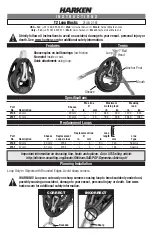
Refrigeration Maintenance
131
8. When the desired micron level has been
achieved (500 to 1000 microns), close valve
V-1 at the pump. Turn the pump off.
9. Observe the reading on the micron gauge after
5 minutes have elapsed. The vacuum rise
should not exceed 2000 microns. If the
vacuum level exceeds 2000 microns after
5 minutes, a leak is present or additional
evacuation time is required.
10. If the vacuum level is acceptable, start the
pump and open valve V-1 to evacuate the
pressure rise (5 minutes).
11. Close valve V-1 and stop the pump. Observe
the micron gauge to confirm that the system
remains in a deep vacuum. Close valve V-4.
The unit is ready to charge.
Unit Charging
NOTE: Before charging, make sure that the
refrigerant lines from the gauge manifold to the
refrigerant supply bottle have been evacuated or
purged.
1. Backseat the suction service valve and make
sure the receiver tank outlet valve is still open.
2. Set the refrigerant supply bottle to liquid and
open the hand valve.
3. Open the high side gauge manifold valve. Add
a partial charge of 10 lbs (4.5 kg) of liquid
refrigerant and close the high side gauge
manifold valve. The remainder of the charge
will be added as a liquid through the low side
gauge manifold valve.
4. Back seat (close) the receiver tank outlet
valve, remove the evacuation station hoses,
and install the cap on the service port for the
receiver tank outlet valve.
5. Attach the gauge manifold set to the suction
service valve and the discharge service port,
and open the suction service valve one turn. A
low loss fitting must be used on the hose
connected to the discharge service port.
6. Exit the Evacuation Mode by pressing the
EXIT key, and remove the battery charger.
7. Set all zones to run in High Speed Cool
through the HMI Service Test Mode. Refer to
the SPECTRUM TS Microprocessor
Diagnostic Manual (TK 51652) for
information about the Service Test Mode.
8. Observe the suction pressure and slowly open
the low side gauge manifold valve to allow
liquid refrigerant to flow into the compressor
suction service valve.
9. Control the liquid flow so the suction pressure
increases approximately 20 to 25 psig (138 to
172 kPa).
10. Maintain a discharge pressure of at least 300
psig (2068 kPa) while adding refrigerant.
11. Close the low side gauge value when the
receiver sight glass shows 1/2 to 3/4 full.
12. Establish a return air temperature of 0 F
(-18 C), a suction pressure of 13 to 18 psig (90
to 124 kPa), and a discharge pressure of 300
psig (2069). See See “Testing the Refrigerant
Charge with an Empty Box” on page 132.
13. Check the receiver tank sight glass. The
refrigerant level should remain between 1/2
and 3/4 full over a period of no less than five
minutes.
14. When the correct amount of charge has been
added, close the gauge manifold hand valve
and the refrigerant supply bottle hand valve.
NOTE: At these conditions the Liquid Injection
Valve will cycle on and off. As this happens the
refrigerant level in the receiver tank sight glass
will raise and lower. Therefore, monitoring the
receiver tank sight glass for a period of five
minutes to make sure that the average level of
the refrigerant over this five-minute period is
between 1/2 and 3/4 full is required.
Remove Refrigerant Hoses
NOTE: Low loss fittings must be used on hoses
when Schrader port fittings are encountered on
units.
1. With a low loss fitting on the discharge gauge
line, remove this line from the unit.
2. Backseat the suction service valve, and then
crack it open one turn.
Summary of Contents for SPECTRUM TS 30 SR NAD
Page 4: ...4 ...
Page 10: ...Table of Contents 10 ...
Page 20: ...Safety Precautions 20 ...
Page 51: ...Unit Description 51 Figure 19 Front View Figure 20 Back View AJA1350 AJA1500 ...
Page 52: ...Unit Description 52 1 On Off Switch Figure 21 Side View 1 ...
Page 60: ...Unit Description 60 ...
Page 80: ...SPECTRUM TS Operation 80 ...
Page 90: ...Electrical Maintenance 90 ...
Page 100: ...Engine Maintenance 100 Figure 130 Early TK 3 95 Fuel and Oil System Components ...
Page 102: ...Engine Maintenance 102 Figure 131 Late TK 3 95 Fuel and Oil System Components ...
Page 104: ...Engine Maintenance 104 Figure 132 TK376 Fuel and Oil System Components ...
Page 136: ...Refrigeration Maintenance 136 ...
Page 156: ...Hilliard Clutch Maintenance 156 ...
Page 158: ...Structural Maintenance 158 ...
Page 168: ...Remote Evaporator Specifications 168 ...
Page 170: ...Remote Evaporator Maintenance Inspection Schedule 170 ...
Page 176: ...Remote Evaporator Electrical Maintenance 176 ...
Page 180: ...Remote Evaporator Refrigeration Service Operations 180 ...
Page 182: ...Remote Evaporator Structural Maintenance 182 ...
Page 184: ...Remote Evaporator System Diagnosis 184 ...
Page 188: ...Wiring and Schematic Diagrams Index 188 ...
Page 189: ...189 Wiring Diagram Page 1 of 4 ...
Page 190: ...190 Wiring Diagram Page 2 of 4 ...
Page 191: ...191 Wiring Diagram Page 3 of 4 ...
Page 192: ...192 Wiring Diagram Page 4 of 4 ...
Page 193: ...193 Schematic Diagram Page 1 of 3 ...
Page 194: ...194 Schematic Diagram Page 2 of 3 ...
Page 195: ...195 Schematic Diagram Page 3 of 3 ...
Page 196: ...196 ...
















































